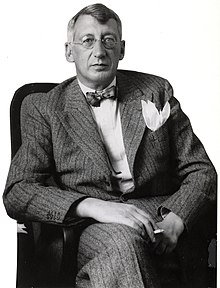Carl Wilhelm Rubenson
Carl Wilhelm Rubenson | |
|---|---|
 Carl Wilhelm Rubenson, c. 1933 | |
| Born | 30 July 1885 Stockholm, Sweden |
| Died | 29 July 1960 (aged 74) |
| Nationality | Norwegian |
| Occupation | Mountaineer and non-fiction writer |
| Awards | Honorary membership of the British Alpine Club and Norsk Tindeklub |
Carl Wilhelm Rubenson (30 July 1885 – 29 July 1960) was a Swedish-born Norwegian mountaineer and non-fiction writer.
Personal life[]
Rubenson was born in Stockholm to landowner Carl Otto Rubenson and Elise Johansen. He married Ragnhild Fougner in 1911.[1]
Climbing career[]
In 1906 Rubenson made several first ascents in Jotunheimen, together with Ferdinand Schjelderup and Agnes Jachelln.[2] In October 1907, Ingvald Monrad Aas and he reached a height of 7,270 m at the Himalayan mountain Kabru, possibly the highest altitude anybody had reached until then.[3][4] However, Rubenson and Aas themselves believed that Graham, , and Kaufmann had reached the same point on Kabru in 1883, an opinion shared with most contemporary climbers and supported by recent analysis.[5] He co-founded the Norwegian mountaineering club Norsk Tindeklub in 1908, together with Alf Bryn, Ferdinand Schjelderup, and others.[2][3] He made the first ascent of the Norwegian mountain Stetind in 1910, together with Alf Bonnevie Bryn and Ferdinand Schjelderup.[6] The three climbers reached the top of Stetind on 30 July 1910,[6] on Rubenson's 25th birthday.[4] This was the first of a number of first ascents to follow the next two weeks in Northern Norway. On 1 August Rubenson, Bryn and Schjelderup made the first ascent of Svolværgeita, on the Lofoten island of Austvågøy. Their route is called 1910 Ruta ("The 1910 Route"). This route includes a famous diagonal traverse across the north wall of the mountain, which was led by Rubenson. The group reached the top by 11 pm on 1 August.[7] On 3 August 1910 the same group climbed Trakta on Northern Austvågøy, a mountain considered among the hardest summits to reach in Norway. Also this was a first ascent, where they climbed the main summit (Vestre Trakta) via the Northwest Ridge.[7] Rubenson was part of the group that first attempted a winter ascent of Store Skagastølstind, but this attempt failed because of harsh snow conditions and risk of avalanches.[2]
Among Rubenson's books are Fjeldsport før og nu and Med telt og husbaat i Kashmir, both from 1923. He was awarded honorary membership of both the British Alpine Club and Norsk Tindeklub.[2][3]

References[]
- ^ Steenstrup, Hjalmar, ed. (1930). "Rubenson, Carl Wilhelm". Hvem er hvem? (in Norwegian). Oslo: Aschehoug. p. 354. Retrieved 2 February 2019.
- ^ Jump up to: a b c d Lauritzen, Per Roger, ed. (2009). "Rubenson, Carl Wilhelm". Norsk Fjelleksikon (in Norwegian). Friluftsforlaget. ISBN 978-82-91-49547-7.
- ^ Jump up to: a b c Godal, Anne Marit (ed.). "Carl Wilhelm Rubenson". Store norske leksikon (in Norwegian). Oslo: Norsk nettleksikon. Retrieved 27 October 2012.
- ^ Jump up to: a b Per, Hohle (1968). "Norsk tindesport gjennom hundre år". Hundre år i fjellet. Den Norske Turistforening 1868–1968 (in Norwegian). Den Norske Turistforening. pp. 86–99.
- ^ Willy Blaser and Glyn Hughes, Kabru 1883, a reassessment, The Alpine Journal 2009, p. 209
- ^ Jump up to: a b c Lauritzen, Per Roger, ed. (2009). "Stetind". Norsk Fjelleksikon (in Norwegian). Friluftsforlaget. ISBN 978-82-91-49547-7.
- ^ Jump up to: a b Webster, Ed (1994). Climbing in the Magic Islands. A climbing and hiking guidebook to the Lofoten Islands of Norway. Henningsvær: Nord Norsk Klatreskole. pp. 12–14, 207–208, 238–240.
- 1885 births
- 1960 deaths
- Norwegian mountain climbers
- Norwegian non-fiction writers
- Norwegian nature writers
- 20th-century non-fiction writers